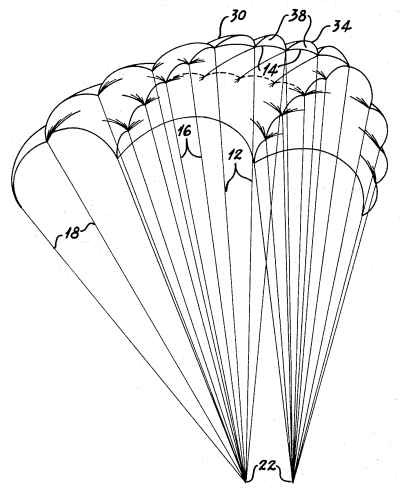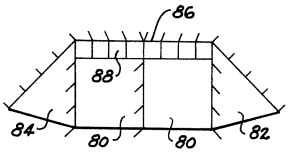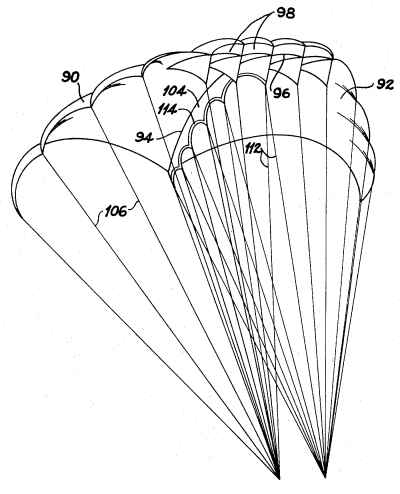William J. Everett Jr. filed for patent the "Gliding Parachute" on February 13th, 1967. Patent 3428277 was granted on February 18th, 1969. Everett was associated with the Pioneer Parachute Company of Manchester, Connecticut. Pioneer Aerospace obtained a license to manufacture parawings from NASA.
The below drawing is figure 3 from the patent. It shows a wing similar to a NASA parawing model 5. The rounded nose of the model 5 is replaced by ram air inflated pockets on the nose, and control lines are added to control the nose section.

Angle of attack is one of the most critical factors in achieving a high lift to drag ratio. However, simply reducing the angle of attack in a standard parawing causes the nose to collapse. The idea behind this alteration is to utilize a small ram air inflated section which would prevent nose collapse at low angles of attack.
The patent text claims an attack angle of 15° for the above model, with a resulting lift to drag ratio of "approximately 3.7 or more."
The patent describes variations to parawing planform. Below, figure 10 shows a parawing with multiple center panels. The patent intends to cover all variations of parawings, the key design element being the addition of ram air chambers in the nose.

Several enhancements to the basic nose air chambers are also described. Figure 14 below shows 3 of them on a single keel parawing variation:
- Profiles added between the air chambers to better control the airfoil shape and allow for ventelation between the chambers.
- A keel is used to spread line loads to the canopy, create a smooth shape, and to help with directional stability.
- "Vertically extending vanes" are added to the nose to "aid in directing air inwardly beneath the canopy to increase the lift" and "keep the leading edge of the parachute facing in the direction of intended flight".

This patent has many enigmatic aspects, among them:
- This patent was filed in February, 1967 and granted in February, 1969. The first NASA publication of a two keel design was in May of 1969. Since the claims in the patent do not include the dual keel aspect, it must be that the dual keel variation was "common knowlege" in certian circles as early as 1967.
- This patent shows a design quite similar in complexity to a "standard" NASA parawing model 5, but with an achievable lift to drag ratio considerably higher. One would expect that this model would have been the basis for kite designs, but none have been seen so far.
- There appear to be no internet references to this design either as a parachute or a kite. This design does not seem to have been put into production by Pioneer Parachute.
The idea to use ram air to prevent nose collapse has been re-invented more than once. For example patent 4243191 "Hooded Kite", granted January 6th, 1981, appears to use exactly this idea to prevent a sled kite's nose collapse at low angles of attack. The "Hooded Kite" patent does not reference the Everett patent.
Related pages:
NPWC Foil Nose
FoilNose2